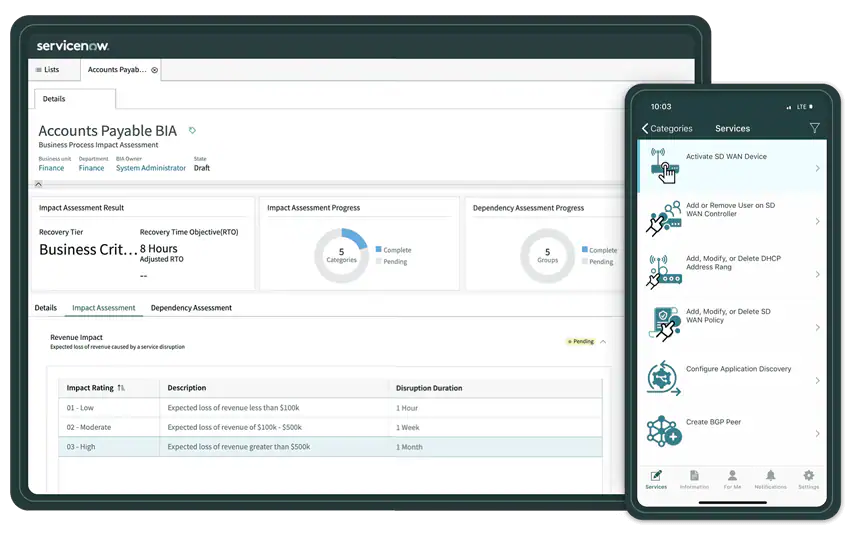As businesses continue to expand and become more complex, the need for integrating platforms is more prevalent than ever. Smartsheet and ServiceNow are both powerful tools that serve different purposes. Smartsheet is a cloud-based collaboration and project management tool that helps teams manage their work and projects more effectively. ServiceNow, on the other hand, is a platform for IT service management that helps organizations manage IT services, demands, incidents, and requests. By integrating these two platforms, organizations can streamline their project and service management processes and achieve better results.
Why Both?
Companies using ServiceNow to manage IT service requests and incidents are familiar with the importance of tracking and managing project requests efficiently. Imagine a scenario where one of your clients has requested a custom software solution that requires a new project to be created. In this case, it is crucial to track the demand management process in ServiceNow and manage the project in Smartsheet to ensure smooth collaboration between various stakeholders and team members.
The first step in this process would be to create a new service request for the custom software solution in ServiceNow. This action would trigger the demand management process in ServiceNow, which involves various stakeholders reviewing and prioritizing the request based on business value, available resources, and other criteria. Once the request has been approved, you can proceed with the project.
By using ServiceNow to manage the demand management process, you can ensure that all stakeholders are on the same page when it comes to the project request. The process involves reviewing and prioritizing requests based on factors such as business value, available resources, and other criteria. This helps to ensure that the project aligns with the company’s goals and is feasible with the available resources.
Once the request has been approved, the project can be moved to Smartsheet for effective project management. Smartsheet offers a comprehensive range of automation features that streamline project management. These include task assignment to team members, progress tracking, and project schedule management.
Furthermore, Smartsheet’s automation capabilities are particularly beneficial for organizations that are using ServiceNow and Smartsheet in conjunction. Through automation, these organizations can improve cross-platform communication, data migration, and efficiency, saving valuable time and resources.
Additionally, Smartsheet’s reporting and dashboard features cater to a variety of audiences. Executives can benefit from high-level dashboards that provide an overview of the project’s progress and performance. Meanwhile, project leads can access detailed reports that offer a more granular view of the project’s status. IT leads can also leverage Smartsheet’s dashboards to monitor project performance and identify potential issues. Overall, Smartsheet’s versatile reporting and dashboard capabilities can provide value to organizations across all levels and departments.

Integration in action
By linking project management data with the demand management process, organizations can achieve greater efficiency and productivity. For example, when an issue or delay arises in a project, the integration allows for seamless communication between Smartsheet and ServiceNow. The status of the project can be updated in Smartsheet, and an incident can be created in ServiceNow to track the issue and ensure a prompt resolution.
One of the key advantages of the integration is the automation it brings to project and demand management processes. The integration eliminates the need for manual data entry and the potential for errors. By automating data transfer between the two platforms, organizations can save time and reduce the risk of data inaccuracies.
Another significant benefit of linking ServiceNow with Smartsheet is the increased visibility it provides. The integration allows stakeholders to view data from both platforms in one place, providing a more comprehensive view of project and service delivery performance. This cross-team visibility enables teams to collaborate more effectively and make data-driven decisions.
Additionally, by bringing ServiceNow data into Smartsheet, organizations can create a single source of truth for project and service delivery data. This ensures that everyone is working with the same data, reducing the potential for confusion and errors.
Best Practices for Integrating Smartsheet and ServiceNow
When integrating any two Software as a Service (SaaS) systems, it is critical to have a seamless and successful implementation. However, there are common challenges that organizations face when attempting to integrate their SaaS systems.
One of the most common challenges is impartial connections. SaaS systems may not have a direct integration with each other, which can lead to delays or errors during the integration process. This often requires a workaround, such as using a third-party integration platform or developing a custom API.
Another challenge is gaps in field-mapping, which can cause data to be lost or misinterpreted during the integration process. It’s crucial to ensure that the data fields in each system match appropriately to avoid errors.
Resource availability can also be a challenge. SaaS integrations require specialized technical expertise, and many organizations may not have the in-house resources to perform the integration effectively. This can result in delays or a poorly executed integration that causes more problems than it solves.
These challenges may seem minor, but they can have a significant impact on the success of your SaaS integration. Failure to address these issues can result in data loss, decreased productivity, and increased costs. Ultimately, a poorly executed SaaS integration can lead to frustration and lost revenue.
Here are some best practices to consider when integrating Smartsheet and ServiceNow:
- Define your Goals: Before you start integrating Smartsheet and ServiceNow, define your goals and objectives. Identify the processes you want to automate, the data you want to transfer, and the outcomes you want to achieve.
- Choose the Right Integration Platform: There are several integration platforms available in the market that can help you integrate Smartsheet and ServiceNow. Choose an integration platform that is easy to use, offers robust configuration features, and provides excellent customer support.
- Map your Workflows: Map your workflows before integrating Smartsheet and ServiceNow. This will help you identify the data fields you want to transfer and the triggers that will initiate the data transfer.
- Test and Refine: Once you have integrated Smartsheet and ServiceNow, test the integration thoroughly. Identify the areas that need improvement and refine the integration until you achieve the desired outcomes.

When it comes to integrating ServiceNow and Smartsheet, the market offers a glut of limited API integrators, but Smartsheet Bridge stands out as the best solution available. One of the key advantages of Smartsheet Bridge is its instantaneous transfer of data, which ensures that data is always up-to-date and accurate. This real-time synchronization capability is critical for organizations that need to share data quickly and efficiently between their ServiceNow and Smartsheet platforms.
Additionally, Smartsheet Bridge’s ability to map data points based on column IDs is a significant benefit. This feature ensures that data is effectively migrated, even if column names are changed in Smartsheet. This not only simplifies the migration process, but also ensures that data is accurate and consistent across both platforms.
Another major advantage of Smartsheet Bridge is its ability to parse out stakeholder emails and migrate them effectively between the active directories of Smartsheet and ServiceNow. This makes it easy to maintain stakeholder data across both platforms, ensuring that communication is seamless and efficient.
Finally, Bridge has an extremely user-friendly interface, which makes it easy to set up and configure the integration. This is particularly important for organizations that don’t have a lot of technical expertise, as they can still take advantage of the benefits of the integration without needing extensive coding or development knowledge.
Conclusion
Integrating Smartsheet and ServiceNow can bring a host of benefits to organizations, from streamlined project management to more efficient service delivery. However, without the right approach, integration can quickly become a headache.
To overcome these challenges and ensure successful integration, organizations are best served working with expert systems integration providers like CORTAC. With extensive experience in Smartsheet and ServiceNow integration, CORTAC guides organizations through the process of defining goals, implementation, training, and documentation. This expert support minimizes the risk of integration failure and ensures that organizations reap the full benefits of their Smartsheet and ServiceNow integration.
With the help of CORTAC, organizations can unleash the full potential of Smartsheet and ServiceNow integration, achieving greater visibility and automation, improving collaboration, and increasing productivity.

